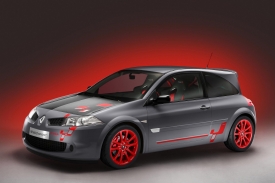When French automaker Renault Sport decided to create a higher-performing, limited-edition version of its turbocharged Mégane R26 – the new Mégane Renault Sport R26.R – it was time to put the vehicle on a diet.

The goal was to coax higher performance from the car while still using the existing 227bhp engine from the Mégane R26 by reducing overall vehicle weight. To achieve this goal, Renault worked with tier 1 supplier, Plastrance, to select SABIC Innovative Plastics’ lightweight, high-optical quality Lexan* polycarbonate (PC) sheet and a proprietary Exatec* blackout ink technology to replace the glass backlight and quarter windows of the new vehicle. This glazing application marks the first commercial use of Exatec ink technology.
Plastrance, known for producing tailor-made, high-quality plastic elements by machining or thermoforming according to OEM needs, designed the technology in close collaboration with Renault and SABIC Innovative Plastics. Compared to the Mégane R26, the customized R model trims a total of 123 kilograms or 275 pounds of weight off the vehicle, bringing it down to a svelte 1,235 kilograms or 2,722 pounds. The Lexan polycarbonate glazing technology enabled 5.7 kilograms or 12.6 pounds of the weight reduction compared to if traditional glass had been used.
“Our collaboration with Plastrance and Renault Sport helped make this limited Renault R26.R a great success,” said John Madej, president, Exatec, LLC. “At SABIC Innovative Plastics we consistently offer our customers solutions to help automotive OEMs achieve their goals, and this is no exception. In its first commercial application, our new Exatec ink technology combined with the Lexan sheet solution has proven its exceptional value in terms of weight-out and design innovation. The new, high-performance Mégane R26.R exemplifies the marriage of practical performance and aesthetic excitement that is now possible in glazing systems.”
Surpassing Glass with Enhanced Design Freedom
Creating the distinctive windows envisioned for the Mégane sports car was a challenge in several respects. The polycarbonate glazing had to equal the optical quality of glass while also surpassing glass in design freedom and weight savings. Renault’s R&D department worked very closely with Plastrance, SABIC Innovative Plastics, Exatec and KRD Coatings GmbH to validate the complex technology.
Thanks to the Lexan sheet with special Exatec ink technology, the windows offer it all: sleek, curved shapes accented by the blackout areas; crystal clarity and exceptionally low-optical distortion for optimal visibility; and high-impact resistance for safety. Longtime SABIC Innovative Plastics’ collaborator, Momentive Performance Materials, provides AS4000 silicone hardcoat technology, which offers excellent resistance against abrasion and chemical degradation in these glazing applications.
The proprietary Exatec ink technologies enabled Renault Sport to graphically depict the June 23, 2008 lap record time of 8 minutes 17 seconds around the famous Nürburgring circuit, in Nürburg, Germany – the fastest ever for a front-wheel drive production car. Contours of the racing track and the record lap time are printed on the left and right rear quarter windows of the Mégane, offering a unique design.
The curved backlight window and quarter windows all make use of a new Exatec blackout printing technology that is applied to the tinted, drape-formed Lexan sheet material. This blackout technology helps to protect the window bonding from degradation due to ultraviolet light exposure, while adding a distinctive design element.